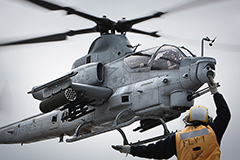The Bell AH-1Z Viper is an American twin-engine attack helicopter, based on the AH-1W SuperCobra, that was developed for the United States Marine Corps as part of the H-1 upgrade program. The AH-1Z features a four-blade, bearingless, composite main rotor system, uprated transmission, and a new target sighting system. The AH-1Z, one of the latest members of the prolific Huey family, is also called "Zulu Cobra".
 The AH-1Z incorporates new rotor technology with upgraded military avionics, weapons systems, and electro-optical sensors in an integrated weapons platform. It has improved survivability and can find targets at longer ranges and attack them with precision weapons.
The AH-1Z incorporates new rotor technology with upgraded military avionics, weapons systems, and electro-optical sensors in an integrated weapons platform. It has improved survivability and can find targets at longer ranges and attack them with precision weapons.
The AH-1Z's new bearingless, hingeless rotor system has 75% fewer parts than that of four-bladed articulated systems. The blades are made of composites, which have an increased ballistic survivability, and there is a semiautomatic folding system for storage aboard amphibious assault ships. Its two redesigned wing stubs are longer, with each adding a wingtip station for a missile such as the AIM-9 Sidewinder. Each wing has two other stations for 2.75-inch (70 mm) Hydra 70 rocket pods, or AGM-114 Hellfire quad missile launchers. The AN/APG-78 Longbow fire control radar can also be mounted on a wingtip station.
The Z-model's integrated avionics system (IAS) has been developed by Northrop Grumman. The system includes two mission computers and an automatic flight control system. Each crew station has two 8×6-inch multifunction liquid crystal displays (LCD) and one 4.2×4.2-inch dual function LCD display.
 The communications suite combines a US Navy RT-1824 integrated radio, UHF/VHF, COMSEC and modem in a single unit. The navigation suite includes an embedded GPS inertial navigation system (EGI), a digital map system and Meggitt's low-airspeed air data subsystem, which allows weapons delivery when hovering.
The communications suite combines a US Navy RT-1824 integrated radio, UHF/VHF, COMSEC and modem in a single unit. The navigation suite includes an embedded GPS inertial navigation system (EGI), a digital map system and Meggitt's low-airspeed air data subsystem, which allows weapons delivery when hovering.
The crew are equipped with the Thales "Top Owl" helmet-mounted sight and display system. The Top Owl has a 24-hour day/night capability and a binocular display with a 40° field of view. Its visor projection provides forward looking infrared (FLIR) or video imagery. The AH-1Z has survivability equipment including the Hover Infrared Suppression System (HIRSS) to cover engine exhausts, countermeasure dispensers, radar warning, incoming/on-way missile warning, and on-fuselage laser spot warning systems.
The Lockheed Martin Target Sight System (TSS) incorporates a third-generation FLIR sensor. The TSS provides target sighting in day, night, or adverse weather conditions. The system has various view modes and can track with FLIR or by TV. The same system is also used on the KC-130J Harvest HAWK. More details
 The AH-1Z incorporates new rotor technology with upgraded military avionics, weapons systems, and electro-optical sensors in an integrated weapons platform. It has improved survivability and can find targets at longer ranges and attack them with precision weapons.
The AH-1Z incorporates new rotor technology with upgraded military avionics, weapons systems, and electro-optical sensors in an integrated weapons platform. It has improved survivability and can find targets at longer ranges and attack them with precision weapons.The AH-1Z's new bearingless, hingeless rotor system has 75% fewer parts than that of four-bladed articulated systems. The blades are made of composites, which have an increased ballistic survivability, and there is a semiautomatic folding system for storage aboard amphibious assault ships. Its two redesigned wing stubs are longer, with each adding a wingtip station for a missile such as the AIM-9 Sidewinder. Each wing has two other stations for 2.75-inch (70 mm) Hydra 70 rocket pods, or AGM-114 Hellfire quad missile launchers. The AN/APG-78 Longbow fire control radar can also be mounted on a wingtip station.
The Z-model's integrated avionics system (IAS) has been developed by Northrop Grumman. The system includes two mission computers and an automatic flight control system. Each crew station has two 8×6-inch multifunction liquid crystal displays (LCD) and one 4.2×4.2-inch dual function LCD display.
 The communications suite combines a US Navy RT-1824 integrated radio, UHF/VHF, COMSEC and modem in a single unit. The navigation suite includes an embedded GPS inertial navigation system (EGI), a digital map system and Meggitt's low-airspeed air data subsystem, which allows weapons delivery when hovering.
The communications suite combines a US Navy RT-1824 integrated radio, UHF/VHF, COMSEC and modem in a single unit. The navigation suite includes an embedded GPS inertial navigation system (EGI), a digital map system and Meggitt's low-airspeed air data subsystem, which allows weapons delivery when hovering.The crew are equipped with the Thales "Top Owl" helmet-mounted sight and display system. The Top Owl has a 24-hour day/night capability and a binocular display with a 40° field of view. Its visor projection provides forward looking infrared (FLIR) or video imagery. The AH-1Z has survivability equipment including the Hover Infrared Suppression System (HIRSS) to cover engine exhausts, countermeasure dispensers, radar warning, incoming/on-way missile warning, and on-fuselage laser spot warning systems.
The Lockheed Martin Target Sight System (TSS) incorporates a third-generation FLIR sensor. The TSS provides target sighting in day, night, or adverse weather conditions. The system has various view modes and can track with FLIR or by TV. The same system is also used on the KC-130J Harvest HAWK. More details